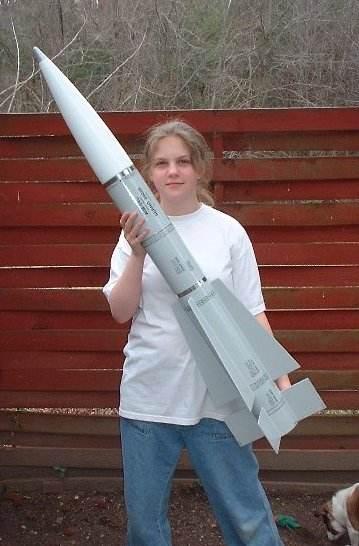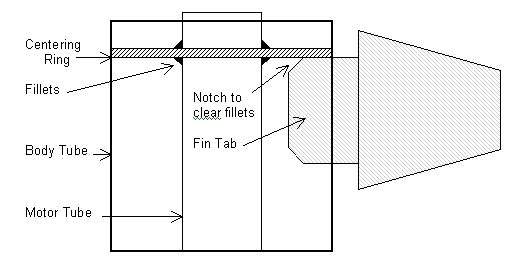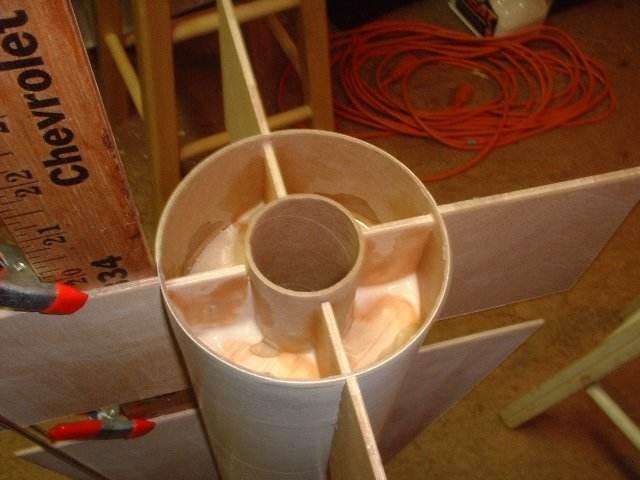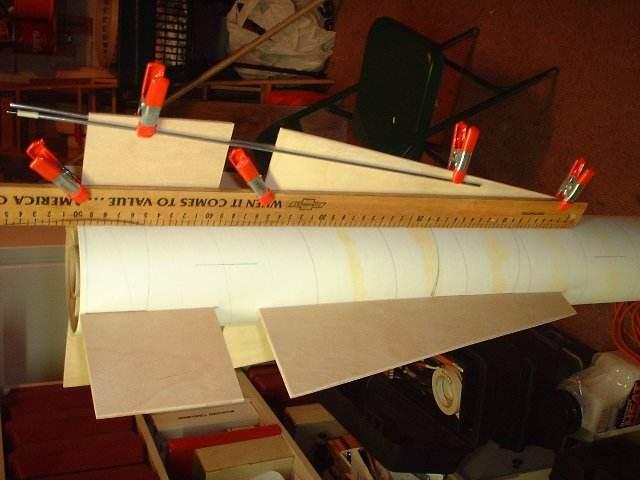
Constructing the THOY Phoenix
This is a high power rocket kit originally developed by Tiffany Hobbies Of Ypsilanti (Michigan?), and now produced by Rocket R&D. The suggested motors run from G to H, but unless you build very light, G’s might work only on absolu
tely calm days. I won this kit in an online raffle sponsored by Magnum Hobbies almost three years ago, but waited until this winter to build it.
Components
The included parts are of very high quality. The 4" body tube is thick-walled kraft paper, with marks showing where the fin slots and launch lug need to go. You must cut the slots yourself. The fins (8) and centering rings (2) are beautiful, made of 1/8" plywood and cut perfectly. The fins are through the wall, and the tabs go all the way to the motor mount. The top centering ring comes with a braided steel shock cord anchor pre-mounted, and needs only a spot of epoxy to finish it off. The nose cone is from ACE, and interestingly enough has a screw cap located on the bottom instead of the customary plastic loop. The motor mount tube is 38mm. Completing the kit is a ½" launch lug , a nine foot length of nylon webbing (1" wide) shock cord, a 36" nylon parachute, a page of self-adhesive decals for military style detailing, clay for nose weight, along with two pages of instructions, one of which is a general guide to painting and decal placement. The instructions are basic but complete, and include some decent diagrams for assembly steps. It is assumed that you have some building experience. Apparently, at some point a different nose cone was supplied, because the instructions call for tying the shock cord to the plastic loop on the nosecone, which, as noted above, doesn't exist. The decals were the weakest part of the kit. I don't much like self-adhesive decals anyway, but these were among the worst I've seen. The printing was smudged in several places and peeling in others (age may have been a problem). The finished product is acceptable from 6 feet away, which is good enough for me, but the decals really disappoint close up. A little effort to re-create your own water slide decals to match, or to have them cu
stom made is an option to consider.
Construction
For the most part, construction was straightforward. The fin slots were cut using a new x-acto blade and a straightedge. Take your time and don't try to cut all the way through at once and you'll be done before you know it.
The instructions give measurements to sand the fins to their true scale shape, but after slightly goofing up the first fin, I just rounded them all off. Elmers Fill ‘n’ Finish was used to seal and fill the grain on the fins and to fill the body tube spirals.

To me, the biggest worry about any Phoenix model are those rear fins. They just look like a pop off waiting to happen. To further strengthen this area, I added a third centering ring to sandwich the tabs of the lower fins. This extra ring was made of two thicknesses of balsa, glued together with the grains running perpendicular, and then thin CA was soaked into the wood. Very light and strong.
One trick I've found w
henever working with fin tabs that go all the way to the motor tube is to trim a small bit of the corner where it's going to meet a centering ring. This way there’s room for any glue fillet that might already be present. See the illustration for what I mean.
The instructions are very clear, and make assembling the motor mount and fins a two-step process, first the motor mount, then the fins. I'll describe here how I did it, which was to combine the steps into one. The reason I did it my way was to strengthen the bottom fin section using that extra centering ring.
Before doing this, drill two small holes in the balsa ring and thread some string through them. These are your handles, and you'll see what they're for in a minute.
First thing is to glue the front centering ring into place on the motor tube as indicated in the instructions. When dry, I slipped the balsa ring over the back end of the motor tube without gluing it, just to center the motor tube correctly. Then I set the rocket upright and drizzled more glue around the joint where the top centering ring meets the body tube. Tilt the tube slightly to make sure the entire edge of the ring is glued to the tube wall.
Once dry, I turned the rocket over again and, using those string handles, removed the bottom centering ring. Now I glued the forward set of fins into place, making sure that they were aligned correctly. Fillet well on the inside where the tab comes through the slot and at the motor tube joint.
At this point, I had to straighten the forward fins, because two of them had developed a slight bow from leading to trailing edge. The way I did this was to clamp a straight steel bar along the length of the fin, which forced it straight. Next came punching small holes into the body tube along the fin root, which allows the epoxy to flow into them and create ‘rivets’ as it cures. The final step was laying a good fillet of epoxy along the fin root. The glue held the entire fin root straight, which removed the warp from the plywood. Each side of each fin was done the same way.
Time for the second centering ring (the one made from balsa) and bottom fins. Place the centering ring on the tube, and let it slide down past the bottom fin tab slots. Next, insert the bottom fins through the slots, mix up a small batch of 5 minute epoxy, and use the string to pull the centering ring up tight against the bottom fin tabs. Add small dabs of epoxy between the fin tabs along the body tube wall and motor tube, so that once the epoxy cures the ring is in place. The fins are still not glued into place, just the balsa centering ring, which acts as a ‘floor’ for the lower fin tabs (see the picture).

The bottom fins must be aligned with the top fins before gluing them into place. I used a straight wooden yardstick clamped along the length of the upper fin, then clamped in turn to the bottom fin to get the alignment needed. This lined up the fin roots, but to ensure that the two fins both were at the same angle to the tube, I used an Estes 2-piece rod, and clamped one half on each side of the fins, running with the leading edge (see the picture). Then I glued the fin and fin tab into position. Fillet everything well, inside and out. Let it dry, then do the next fin. When you're done, you'll have a rock solid assembly for the bottom fins, and they'll be perfectly aligned.

Once dry, I fastened the bottommost centering ring into place, and filleted it well. Instead of centering the launch lugs between the fins as called for in the instructions, I offset th
em slightly closer to one side, so that I could install rail buttons as well.
On to the nosecone. After lightly sanding to remove the mold seam, as well as to provide some ‘tooth’ for the finish to hold on to, I packed the supplied clay into the nosecone. Using a dowel as a ramrod, the clay was pushed as far as possible towards the tip. Next I drilled several 1/16" holes through the nosecone at the level of the clay. Covering these holes with masking tape, I then poured a batch of 15 minute epoxy into the nosecone, on top of the clay. Once again, the epoxy ran into the holes, creating rivets as it cured and ensuring that the clay would stay right at the top of the nose. Once cured, the masking tape was removed, and the holes and rivets were sanded smooth.
Finishing
I covered the entire rocket with 3 coats of ruddy brown automotive primer, lightly sanding between coats. This primer has a high solids content, and filled the last of the spiral grooves and wood grain. Read the can though! The brown primer that I used was leftover from some auto bodywork I did a while back, and had a drying time of 5 days, which I've never heard of before for any other primer (and didn't think about until after I'd already sprayed the first coat). The body of the Phoenix is pale dove gray, so – 5 days later – I next sprayed the body with 2 coats of Krylon white primer, sanding between coats. I was worried that the gray would have a hard time covering the brown primer, so I chose the white to lighten the final coat color even more. The nosecone is white, so I used Krylon gray primer there, mainly so I could tell when I had good coverage on the final color coat. Spraying white paint on white primer is tough. I set the whole thing aside to dry for a week.
Final Details
The markings guide provided in the instructions is pretty general, and since this is just ‘scale like’, I didn't feel real obligated to follow it t
o the letter. I opted to simplify the striping scheme, mostly to cut down on the difficult masking needed (probably my least favorite rocket building step). The silver stripes are mylar tape. The decals were added more or less where indicated, and the tip was painted silver using a brush and Testors silver model paint from a jar. Once again I set it aside for several days, then clear coated everything using Future floor finish applied with a soft rag.
I didn't use the supplied nylon webbing for the shock cord, preferring 20 feet of 3/8" tubular nylon attached with a quick link. At the nosecone end, I drilled two holes on either side of the screw cap – one on each molded half - and threaded more tubular nylon through both holes as a harness where the shock cord can be attached with another quick link. There would have to be massive structural failure of the entire base of the nosecone to experience a separation failure at that point.
Motor retention clips were formed from strip brass stock, fastened with cap screws fitted into blind nuts installed in the rear centering ring. A Pratt heat shield was added as wadding.
The final, full up, everything-but-the-motor weight is 43.5 ounces.
Flight
First flight was at Whitakers, N
orth Carolina on March 25, 2001, on an H180W with a medium delay. At ignition she punched off the pad straight up, moving fast. During the coast phase, the fins made a neat whistling sound, and the chute ejected just after apogee. The chute brought the Phoenix down to a soft landing less than 100 yards from the pad.
Post Flight
The Pratt heat shield did its job perfectly, without so much as a single scorch on the chute or shroud lines. The 36" chute is fine for near-calm days, but I think that on windier days I'll probably use a 32" or even 30" chute, especially since the rear fins are reinforced and should be able to handle a harder landing.
All in all, this is an impressive kit! The Phoenix is a challenge to build without being overly complex, and the end result is a great looking rocket that attracts attention. There was a lot of satisfaction for me in completing this rocket, and the fact that she flies like a dream just made the whole experience that much better. Highly recommended.
Other Reviews
- THOY Phoenix By Carl Tulanko
The THOY Phoenix is a near half scale version of the original Phoenix/AIM-54 used by the U.S Navy as a long range air to air missile. This 4” diameter High Power rocket stands 46” tall and is currently produced by Rocket R & D, who bought the rights to all THOY kits. My kit was ordered directly from Rocket R & D, as all the dealers I called were out of stock. They cut ...
 |
 |
Flights
 |
 |